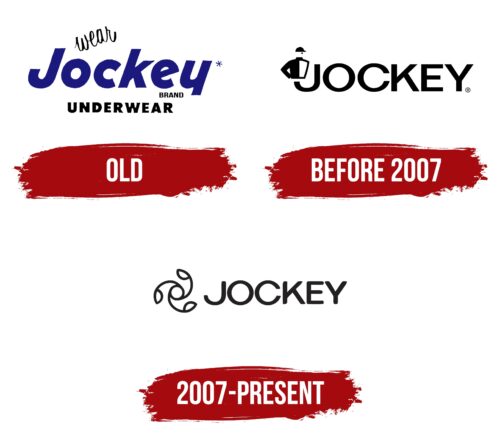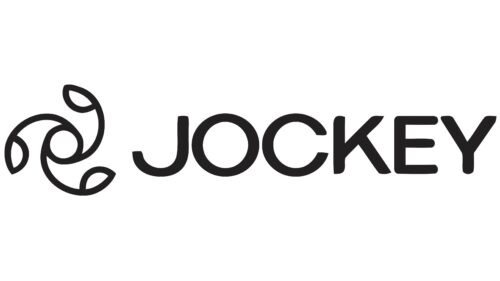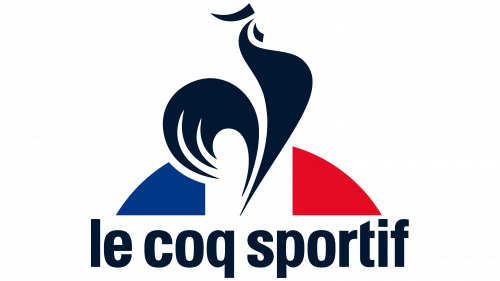The Jockey logo is distinguished by its refinement and softness, emphasizing the characteristics of products designed for direct contact with the body. The emblem speaks of comfort and lightness, creating associations with weightlessness and ease. The smooth curves of the visual symbol are reminiscent of how the brand’s products gently envelop and protect, creating a sense of warmth and care. The dynamic nature of the logo suggests freedom and minimalism, reflecting the brand’s core values.
Jockey: Brand overview
The history of Jockey began in 1876 when Samuel T. Cooper founded the company in St. Joseph, Michigan. Initially called S.T. Cooper & Sons, the business focused on producing wool socks for miners and lumberjacks. The region’s harsh weather and working conditions made durable socks essential for workers, driving the company’s product focus.
In 1900, the company expanded its product line to include underwear, recognizing the growing need for high-quality, comfortable garments among the working class. The brand quickly gained a reputation for producing reliable and durable products.
The 1910s marked a period of innovation for the company. In 1912, the business introduced the “Kenosha Klosed Krotch,” a new style of long boxer shorts that quickly became popular and set the foundation for modern boxer shorts.
A pivotal moment came in the 1920s when Arthur Kneibler, then president of S.T. Cooper & Sons, visited the French Riviera in 1926. He noticed a man wearing swimwear similar to modern swim trunks, which inspired him to create something similar for the U.S. market. In 1934, the company launched the first men’s briefs in the U.S., named “Jockey shorts” because the design provided the same support as a jockstrap. These briefs featured an elastic waistband and a Y-front opening, which was revolutionary then. Despite being launched in the middle of winter in Chicago, all 600 pairs sold out within hours. The success of the shorts was so great that in 1938, the company changed its name to reflect its growing prominence in the underwear market.
During World War II in the 1940s, the company played a key role in producing garments for the U.S. military. The brand designed specialized undergarments for soldiers, providing both comfort and practicality. This collaboration helped improve the quality of the products and contributed to the war effort.
The 1950s marked a period of rapid growth. 1953, the business opened its first international office in Canada, signaling global expansion. Around the same time, the company launched its first television advertising campaign, significantly increasing brand awareness.
Throughout the 1960s, the label continued to innovate, introducing the first seamless briefs, which enhanced consumers’ comfort. The company also began using new synthetic materials like polyester and nylon, which made underwear lighter and faster to dry.
In the 1970s, the business expanded its product line, introducing women’s underwear, loungewear, and sleepwear. This allowed the company to enter new market segments and strengthen its position in the industry.
The 1980s saw further international expansion, opening operations in Asia and Europe. The brand also began sponsoring athletes and participating in sports events, further promoting its image.
During the 1990s, the company embraced new technologies, launching thermal underwear made from advanced materials. The brand also launched its first online store, establishing a digital presence to reach a wider audience.
In the 2000s, the company focused on expanding its product offerings, introducing new lines of sportswear and activewear in response to the rising trend toward healthier lifestyles. The business also increased its global retail footprint, opening stores in several countries.
In recent years, the company has continued innovating in underwear technology, introducing moisture and temperature control products. The brand has also enhanced its online presence through social media marketing and e-commerce.
By 2023, the company remained one of the leading producers of underwear and loungewear worldwide. The brand continued to develop new products and technologies to meet changing consumer needs, maintaining its commitment to quality and innovation. From its founding in 1876 to 2023, the company has grown from a small sock manufacturer into a global lingerie brand, consistently adapting to shifts in the fashion industry and consumer preferences while upholding its reputation for quality and innovation.
Meaning and History
What is Jockey?
This American company is associated with producing intimate apparel and underwear. The brand is known for its innovative designs, comfort, and high-quality products. The company offers various items for men, women, and children, including underwear, loungewear, sleepwear, and activewear. The invention of men’s briefs became one of the brand’s significant achievements, changing the approach to men’s underwear. The company specializes in fit and comfort, using advanced fabric technologies to enhance comfort and performance.
Old
The underwear emblem includes the brand’s name and clarifies what is sold under this label. Coopers, Inc. founded the brand, and “Jockey” was chosen to reference modern men’s briefs. Originally, the product was positioned as a supportive bandage for the genitals, resembling protective covers used in sports. The name is connected to horseback riding, emphasizing that Jockey briefs are designed for an active lifestyle.
The thin word “wear,” written in cursive, rises above the main name as if sitting in a saddle, hinting at when the product is most in demand. Due to the high popularity of this item, the company eventually changed its name to Jockey Menswear, Inc., reinforcing the connection to the original idea behind the brand.
Before 2007
Elegant, thin, and rounded font, executed in capital letters, has a sporty character, creating a sense of lightness and fitness. The logo appears dynamic and modern. Particular attention is drawn to the first letter “J,” on the tip of which a rider in a suit is depicted, visible to the waist. The rider’s figure integrates seamlessly into the design, where the letter becomes a natural extension of his body, subtly hinting at a clothing detail below, giving the logo a stylish and conceptual touch.
2007 – today
The modern Jockey emblem is a unique symbol resembling a flower with three dynamically rotating petals, representing development, constant forward movement, and steady company growth. This design highlights the brand’s connection to its evolution and demonstrates its commitment to quality and tradition. The three petals symbolize the brand’s key areas of focus: the production of underwear for men, women, and children. At the tips of each petal, figures resembling a scoop are depicted, which refer to the company’s first products with supportive effects for men, creating a strong connection to the brand’s historical roots.
The logo, with its smooth symbol and intertwining lines, creates a sense of harmony and movement. These lines represent comfort and flexibility — the main characteristics of the products. The rounded, smooth shapes of the lines emphasize the softness and comfort that have always been key elements of the brand’s clothing.
The font is large and bold, with rounded letters, most noticeable in the letters “O” and “C.” The font emphasizes softness and ease of perception, avoiding excessive strictness, indicating that the brand is confident in itself and its reputation. The inscription has retained a refined style, adding elegance and maintaining the brand’s distinctive style. The use of capital letters enhances the sense of strength and reliability.
The color is classic black, associated with simplicity, reliability, and durability. Black is a fundamental color, symbolizing practicality, just like the always relevant products that never go out of fashion. The logo’s concise design, without unnecessary details, reflects the stability and comfort the brand has offered its customers for many years.







